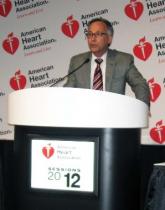Conference Coverage

Dalcetrapib Boosts HDL Without Benefiting Patients
Major Finding: After a median 31 months, patients treated with dalcetrapib or placebo showed no significant difference in primary end point events...
EXPERT ANALYSIS FROM THE ANNUAL CARDIOVASCULAR CONFERENCE AT SNOWMASS
SNOWMASS, COLO. – The once highly attractive notion that boosting HDL cholesterol levels will reduce cardiovascular event rates is now dead, or more generously, it remains unsupported by evidence despite expenditure of billions of dollars on negative clinical trials.
"An iconic concept of HDL has not borne good fruit. It really isn’t what we don’t know that hurts us so much as the things that we think are true but just ain’t so – and that’s the story of HDL," Dr. Robert A. Vogel said at the annual cardiovascular conference at Snowmass sponsored by the American College of Cardiology.
Indeed, it now appears that the relationship between HDL and atherosclerosis is far more complicated than lipidologists thought. Evidence now suggests that HDL mass may not be as important as HDL function, which can switch between being anti- and pro-atherogenic in a matter of hours. And HDL may not even be playing an active role in cardiovascular risk; a low HDL may be associated with an increase in cardiovascular events simply because it is a marker for other cardiovascular risk factors, such as obesity, smoking, and insulin resistance.
"This has been a sea change in thinking for me. HDL is something I thought I understood. But I understood it a lot better 10 years ago than I do now," admitted Dr. Vogel of the University of Colorado, Denver.
HDL-raising drugs from multiple classes have now crashed and burned in large randomized trials with clinical endpoints. Thus, the idea that just because a drug does good things to the lipid profile it follows that the agent will also reduce cardiovascular risk "has to die," the cardiologist continued.
Take, for example, niacin.
"Metabolically, niacin does everything right – if you’re a lipidologist. Absolutely everything. It lowers triglycerides, lowers LDL, raises HDL, lowers total cholesterol, lowers C-reactive protein, and increases the beneficial large HDL particles. You would conclude from this that there would be no way niacin would not reduce cardiovascular risk," he explained.
That’s why the negative results of the National Institutes of Health–sponsored 3,414-patient AIM-HIGH (Atherothrombosis Intervention in Metabolic Syndrome with Low HDL Cholesterol/High Triglycerides and Impact on Global Health Outcomes) trial came as such a surprise. In AIM-HIGH, randomization to 1.5-2.0 g of extended-release niacin daily in patients on background simvastatin and, if need be, ezetimibe, had no impact on major cardiovascular events (N. Engl. J. Med. 2011;365:2255-67).
The final nail in niacin’s coffin came a few months ago in the form of Merck’s preliminary announcement of a negative result in the massive phase III Health Protection Study-2 THRIVE trial, in which nearly 26,000 subjects with cardiovascular disease and/or diabetes in the United Kingdom, Scandinavia, and China were randomized to 2 g of extended-release niacin plus the antiflushing agent laropiprant daily or placebo on top of background therapy with simvastatin plus or minus ezetimibe. During 3.9 years of prospective follow-up, niacin boosted HDL levels by 17% and reduced LDL by 20%, but it had no impact upon cardiovascular events and was associated with increased risk of serious adverse events.
"I’m going to say it twice: If you have a patient on niacin, take that patient off. Again, if you have a patient on niacin, take that patient off. There is no evidence base at the present time that a patient should be on niacin to reduce cardiovascular risk," Dr. Vogel stressed.
The investigational cholesterol ester transfer protein (CETP) inhibitors produce whopping increases in HDL but to date have proved to be a crushing disappointment in large clinical trials. In the ILLUMINATE trial, the CETP inhibitor torcetrapib raised HDL by 70% and lowered LDL by 30% – and yet it increased all-cause mortality by 60%. Development of torcetrapib has been discontinued.
In the 15,871-patient dal-OUTCOMES trial, the CETP modulator dalcetrapib also produced salutary effects on HDL and LDL, but with absolutely no change in cardiovascular events (N. Engl. J. Med. 2012;367:2089-99).
The only anti-CETP drug that still has a prayer of ever reaching the marketplace is anacetrapib. In the ongoing 1,625-subject DEFINE trial, it has produced a 140% increase in HDL and a 40% drop in LDL. But whether the drug improves clinical outcomes remains to be seen.
As for the fibrates, a meta-analysis of six major randomized trials showed these HDL-raisers had no impact on coronary heart disease (CHD) mortality.
Even the hallowed and robust inverse relation between HDL level and cardiovascular risk described 27 years ago in the Framingham Heart Study (JAMA 1986;256:2835-8) has come under question. This inverse association wasn’t evident in the dal-OUTCOMES trial, and was of only borderline significance in the 10,001-patient Treating to New Targets (TNT) trial (N. Engl. J. Med. 2007;357:1301-10).

Major Finding: After a median 31 months, patients treated with dalcetrapib or placebo showed no significant difference in primary end point events...
Major Finding: Cardiovascular events occurred in 16.2% of patients with stable established CHD and low baseline HDL cholesterol whose LDL...
